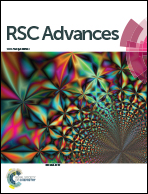Effects of the alkyl group in (dialkylamino)perfluorophenazines on the melting point and fluorescence properties†
Abstract
The alkyl groups in 2-(dialkylamino)- and 2,7-bis(dialkylamino)perfluorophenazines drastically affected the melting point and solid-state fluorescence. 2-(Dialkylamino)- and 2,7-bis(dialkylamino) derivatives such as 2-(dioctylamino)-, 2-(didodecylamino)-, and 2,7-bis(dioctylamino)perfluorophenazines were liquid at ambient temperature, whereas shorter and longer dialkylamino derivatives were solid. 2-(Dioctadecylamino)perfluorophenazine exhibited a fluorescence maximum at 581 nm, being significantly blue-shifted compared with the other derivatives, with the most intense fluorescence quantum yield of 0.29 in the crystalline form. This result is attributed to the isolated dimer-type packing coming from long octadecyl groups. 2-(Dimethylamino)perfluorophenazine showed positive fluorescence solvatochromism due to a large dipole moment in the excited state. The computational analysis of (2-(dimethylamino)perfluorophenazine suggests that the red-shift of the fluorescence maximum in the crystalline form, compared with that in solution, mainly comes from π–π interactions with adjacent molecules. The fluorescence lifetime of 2-(dioctadecylamino)perfluorophenazine was significantly longer compared with 2-(dioctadecylamino)phenazine owing to the aromatic C–F bonds.


 Please wait while we load your content...
Please wait while we load your content...